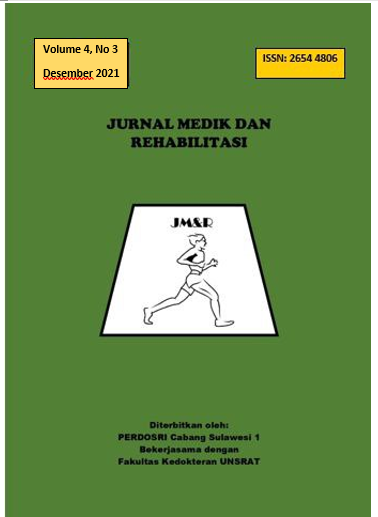MEDICAL REHABILITATION IN PATIENT WITH LEFT BELL’S PALSY
Abstract
Bell’s palsy is a complex neuromuscular facial disorder of unknown etiology commonly affecting the motor neurones of facial muscles receiving their neurological innervations from the seventh cranial nerve (the facial nerve).1 Bell's palsy is named after Sir Charles Bell (1774–1842), who first described the syndrome along with the anatomy and function of the facial nerve.2 The facial nerve not only carries motor fibers including fibers to the stapedius muscle but also supplies autonomic innervations of the lacrimal gland, submandibular gland, sensation to part of the ear, and taste to the anterior two thirds of the tongue via the chorda tympani.3 Bell’s palsy accounts for almost three quarters of peripheral facial palsies and the annual incidence is about 15-30 patients per 100.000 annually.The sexes are affected equally. The median age at onset is 40 years, but the disease may occur at any age. The right and left sides of the face are involved with equal frequency.4,5Treatment of Bell’s palsy varies, and no clear consensus exists. The aims of treatment in the acute phase of Bell's palsy include strategies to speed recovery and to prevent corneal complications. Most physicians prescribe corticosteroids as a primary treatment due to its potential to reduce swelling and inflammation. The addition of antiviral treatment (AVT) such as Acyclovir or Valacyclovir is aimed at eradication of HSV infection.6,7 The treatments at Medical Rehabilitation include facial exercise or facial neuromuscular re-education, electrostimulation, infrared rays, and acupuncture, as well as the need for eye-protective and further assessed with electroneurography or electromyography in the presence of complete facial paralysis.
References
Elliot JM. Physiotherapy Treatment of Bell’s Palsy: A Case Report. NZ Journal of Physiotherapy 2006; 34(3): 167-71.
Tiemstra JD, Khatkhate N. Bell’s palsy: Diagnosis and Management. Am Fam Physician 2007; 76(7): 997-1002.
Finsterer J. Management of peripheral facial nerve palsy. Eur Arch Otorhinolaryngol 2008; 265(7): 743-52.
Waxman SG. Clinical Neuroanatomy 26th ed. New York: McGraw-Hill; 2010. P. 110-1.
Gilden DH. Clinical practice. Bell’s palsy. New England Journal of Medicine 2004; 351: 1323-31.
Beal MF, Hauser SL. Trigeminal Neuralgia, Bell’s palsy, and Other Cranial Nerve Disorders. In: Hauser SL, Josephson SA. Harrison’s Neurology in Clinical Medicine 16th ed. New York: McGraw-Hill; 2012. P. 2435-38.
Aminoff MJ, Kerchner GA. Nervous System Disorders. In: McPhee SJ, Papadakis MA. Current Medical Diagnosis and Treatment 51st ed. New York: McGraw-Hill; 2010. P. 3037-42.
Teixeira LJ, Valbuza JS, Prado GF. Physical therapy for Bell’s palsy (idiopathic facial paralysis). The Cochrane Library 2012; 2: 1-17.
Numthavaj P, Thakkinstian A, et al. Corticosteroid and Antiviral Therapy for Bell’s Palsy: A Network Meta-analysis. BMC Neurology 2011; 11: 1-10.
Murthy JMK, Saxena AB. Bell's palsy: Treatment guidelines. Ann Indian Acad Neurol 2011; 14: 70–2.
VanSwearingen J. Facial Rehabilitation: a Neuromuscular Reeducation, Patient-Centered Approach. Facial Plast Surg 2008; 24: 250-9.
Almeida JR, et al. Management of Bell’s Palsy: Clinical Practice Guideline. CMAJ 2014; 186(12): 917-21.
Xia F, et al. Prednisolone and Acupuncture in Bell’s palsy: study protocol for a randomized, controlled trial. Trials 2011; 12:158.
Ziel GE, Maria BL. Bell’s Palsy. In: Current Management in Child Neurology 3rd ed. New York: BC Decker Inc; 2005. P. 366-9.
Grosheva, et al. Prognostic value of Electroneurography and Electromiography in Facial Palsy. Laryngoscope 2008;118-394-397.
Shafshak TS. The Treatment of Facial Palsy from the Point of View of Physical and Rehabilitation Medicine. Eura Medicophys 2006; 42:41-7.
Lindsay RW, Robinson M, Hadlock TA. Comprehensive Facial Rehabilitation Improves Function in People with Facial Paralysis: A 5-year Experience at the Massachusetts Eye and Ear Infirmary. Physical Therapy 2010; 90(3): 391-7.
Garanbani MR. Cardoso JR. Capelli AM. Ribeiro MC. Physical therapy in peripheral facial paralysis: retrospective study. Rev Bras Otorrinolaringol 2007; 73(1): 112-5.
Quinn R, Cramp F. The efficacy of electrotherapy for Bell’s palsy: a systematic review. Phys Ther Rev 2003; 8:151–164
Ladalardo TC, Brugnera A, Takamoto M et al. Functional and electrophysiological evaluation of the effects of laser therapy in the treatment of peripheral facial paralysis. Lasers in Dentistry VII. Proc SPIE 2001; 4249:134–138
Kneebone WJ. Enhancement of nerve regeneration by therapeutic laser. Practical Pain Management 2010;10(4):70–72
Barbosa RI ,Marcolino AM, DeJesus Guirro RR, MazzerN, Barbieri CH, de Cássia Registr o Fonseca M. Comparative effects of wavelengths of low-power laser in regeneration of sciatic nerve in rats following crushing lesion. Lasers Med Sci 2010;25(3):423–430.
Rochkind S. International Conference of the World Association of Laser Therapy Sun City, North West Province, South Africa 2008;19–22.

